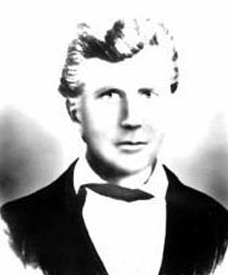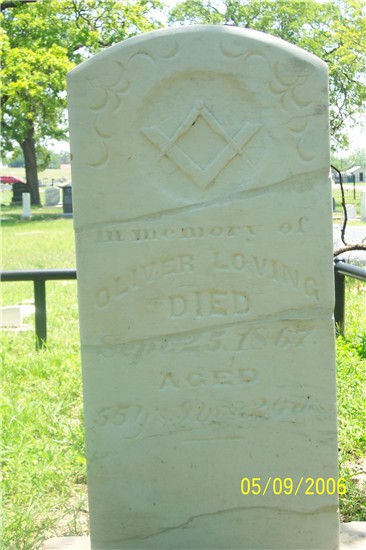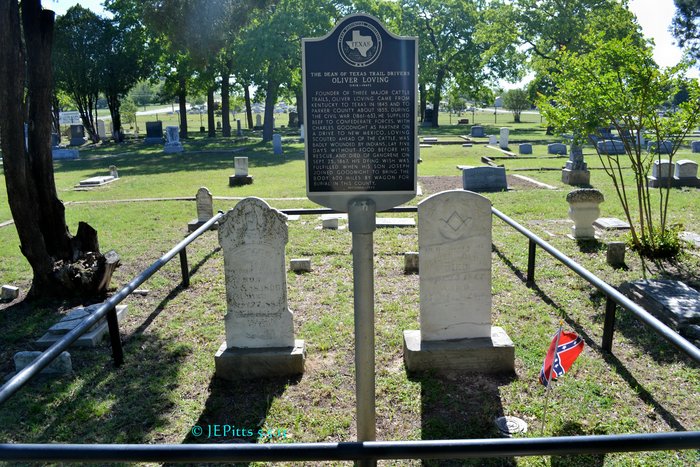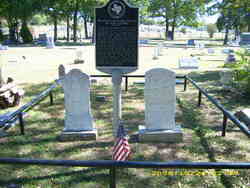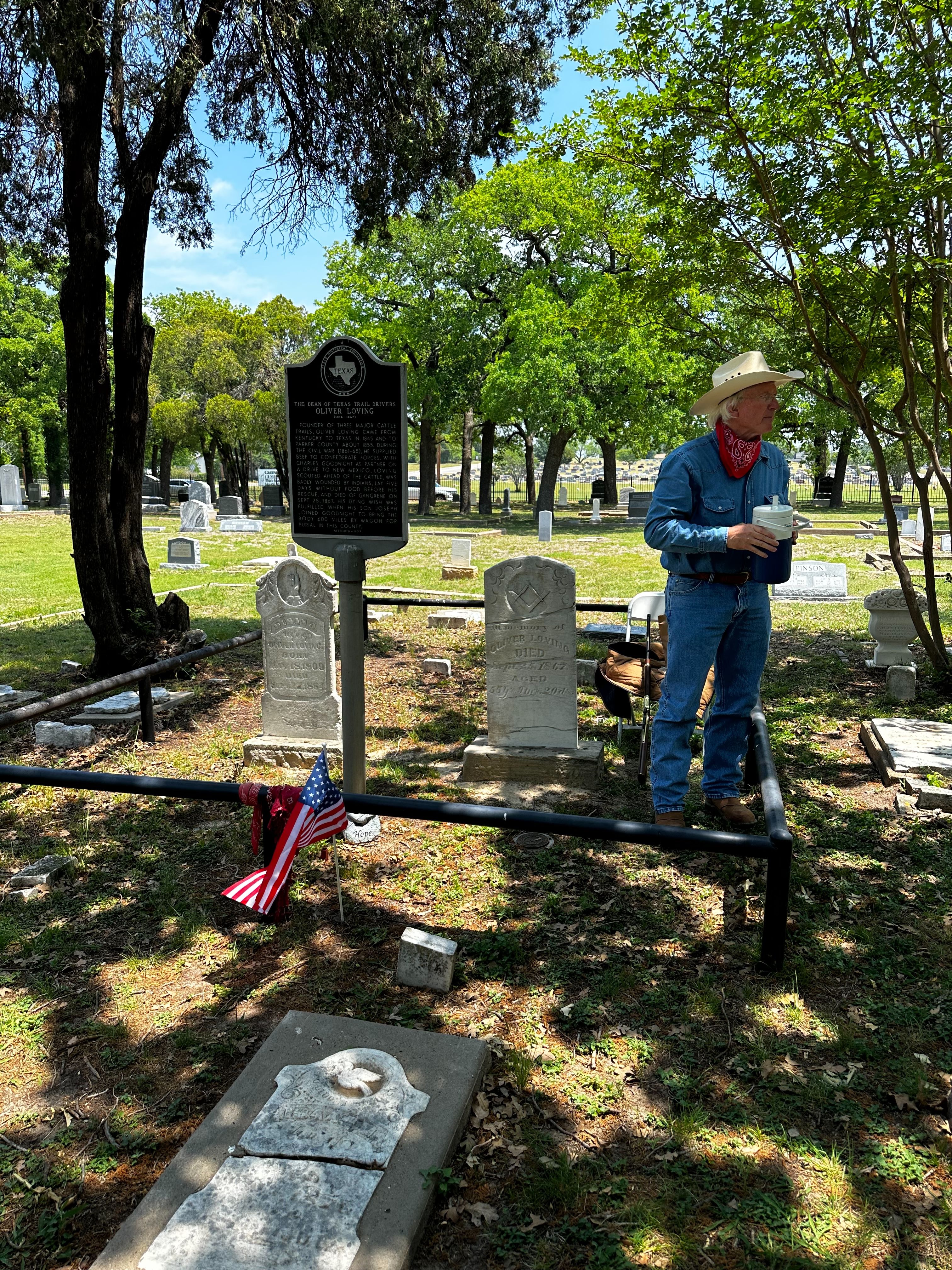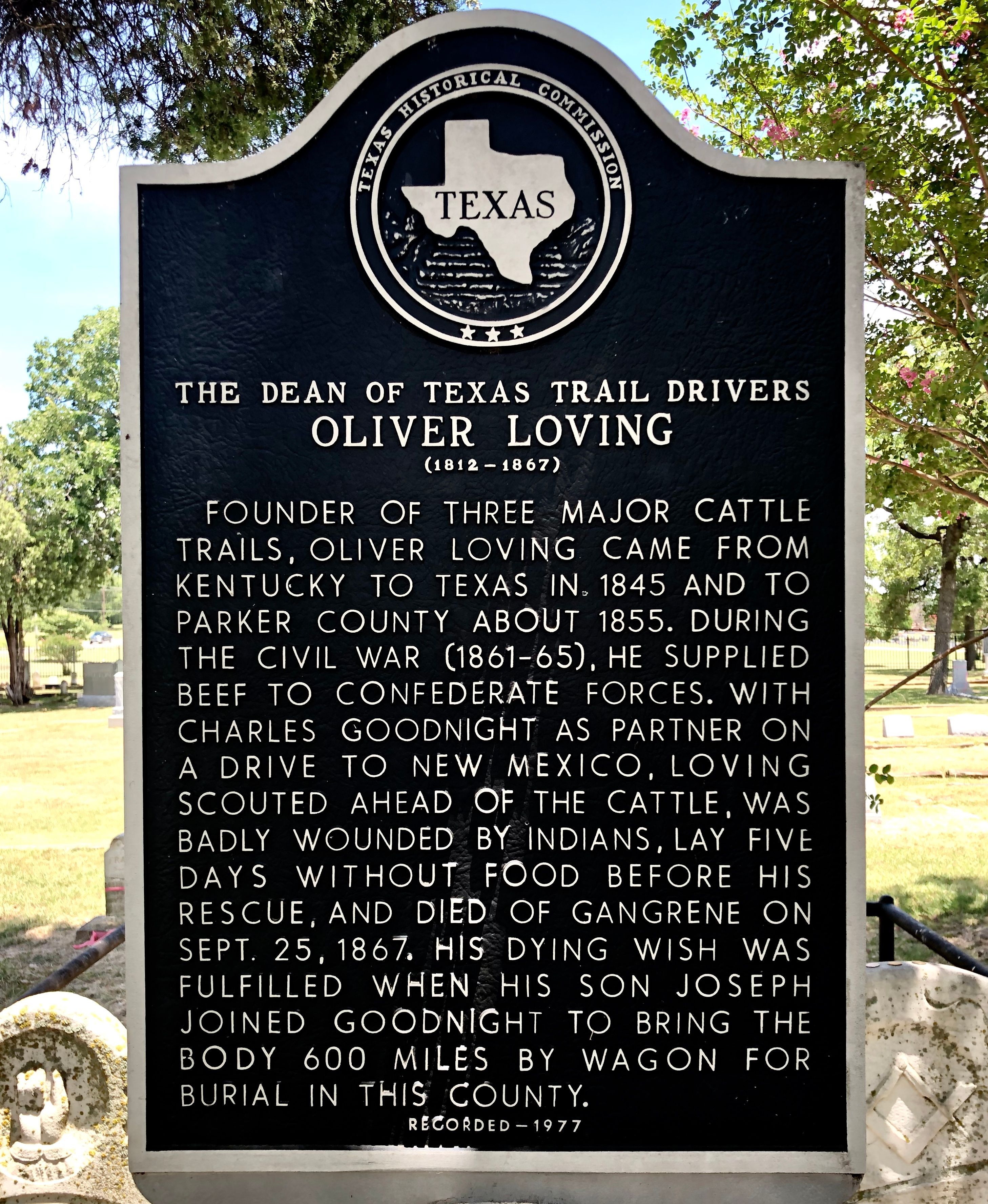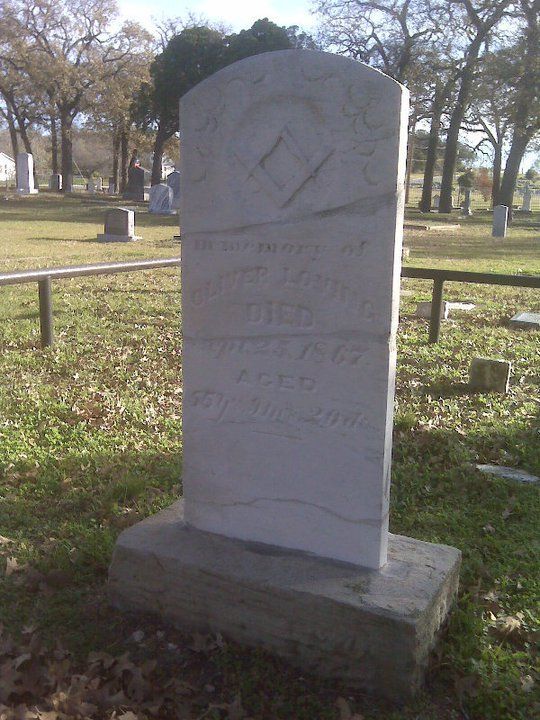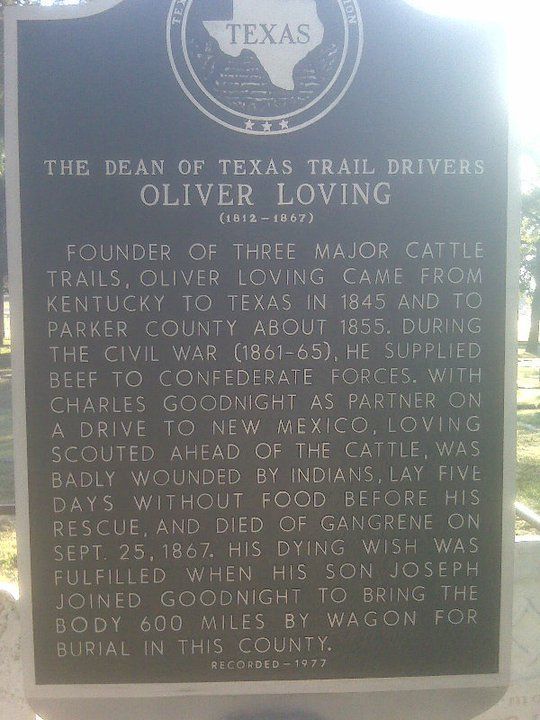Loving was born in Hopkins County, Kentucky. From 1833 to a decade later, Loving was a farmer in Muhlenberg County, Kentucky, until he, his brother, and his brother-in-law moved their families to the Republic of Texas, where Loving received 640 acres (2.6 km²) of land in three patents spread through three counties Collin, Dallas, and Parker. He farmed and, to feed his growing family, hauled freight in his early years as a Texan.
By 1855, the Lovings had moved to the future Palo Pinto County, Texas, where they ran a country store and ranched on Keechi Creek a few miles north of the town of Salesville. In 1857, Loving owned a thousand acres (4 km²) of land. To market his large herd, Loving drove them out of Texas and in that same year he entrusted his nineteen-year-old son, Joseph, to drive his and his neighbors' cattle to Illinois up the Shawnee Trail. The drive made a profit of $36 head and encouraged Loving to repeat the trek successfully the next year with John Durkee.
On August 29, 1860, Loving and John Dawson started a herd of 1,500 toward Denver, Colorado to feed miners in the area. They crossed the Red River, traveled to the Arkansas River, and followed it to Pueblo, Colorado, where the cattle wintered. In the spring, Loving sold his cattle for gold and tried to leave for Texas; however the American Civil War had broken out and the Union authorities prevented him from returning to the South until Kit Carson and others interceded for him.
During the war Oliver Loving was commissioned to drive cattle to Confederate forces along the Mississippi River. When the war ended, the Confederate government reportedly owed him between $100,000 and $250,000. To make matters worse, the usual cattle markets were inadequate for the available supply.
In 1866, having heard about the probable need for cattle at Fort Sumner, New Mexico, where some eight thousand Native American Indians had been settled on a reservation, Loving gathered a herd, combined it with that of Charles Goodnight, and began a long drive to the fort. Their route later became known as the Goodnight-Loving Trail. The two cattlemen sold beef to the army for $12,000 in gold, and then Loving drove the stock cattle on to Colorado and sold them near Denver, while Goodnight returned to Weatherford, the seat of Parker County, Texas, with the gold and also for a second herd. The two men were reunited in southern New Mexico, where they went into partnership with John Chisum at his ranch in the Bosque Grande, about forty miles south of Fort Sumner. (Chisum's sister Nancy was married to Loving's cousin, B.F. Bourland and had known Chisum for many years) They spent the winter of 1866-67 there and supplied cattle from the ranch to Fort Sumner and Santa Fe.
In the spring of 1867, Loving and Goodnight returned to Texas, ready to start a new drive. This third drive was slowed by heavy rains and Native American threats. Loving went ahead of the herd for contract bidding, taking only Bill Wilson, a trusted scout, with him. Although he told Goodnight that he would travel at night through Native American Indian country, Loving became impatient and pushed ahead during the day. His careless action brought a Comanche attack in which he was seriously wounded. The weakened Loving sent Wilson back to the herd, eluded the Native American Indians, and, with the aid of Mexican traders, reached Fort Sumner, only to die there of gangrene. Before he died Goodnight assured him that his wish to be buried in Texas would be carried out. After a temporary burial at Fort Sumner, while Goodnight drove the herd on to Colorado, Goodnight had Loving's body exhumed and returned to Texas. Stories differ as to who accompanied the body back to Weatherford, but he was reburied there in Greenwood Cemetery on March 4, 1868. As a member of Phoenix Lodge No. 275 at Weatherford, Loving was buried with Masonic honors.[1]
Loving has been inducted into the National Cowboy Hall of Fame in Oklahoma City, Oklahoma. In addition to Loving County, Texas, Loving, New Mexico is named in his honor March 1868 by the Masons.
Loving was born in Hopkins County, Kentucky. From 1833 to a decade later, Loving was a farmer in Muhlenberg County, Kentucky, until he, his brother, and his brother-in-law moved their families to the Republic of Texas, where Loving received 640 acres (2.6 km²) of land in three patents spread through three counties Collin, Dallas, and Parker. He farmed and, to feed his growing family, hauled freight in his early years as a Texan.
By 1855, the Lovings had moved to the future Palo Pinto County, Texas, where they ran a country store and ranched on Keechi Creek a few miles north of the town of Salesville. In 1857, Loving owned a thousand acres (4 km²) of land. To market his large herd, Loving drove them out of Texas and in that same year he entrusted his nineteen-year-old son, Joseph, to drive his and his neighbors' cattle to Illinois up the Shawnee Trail. The drive made a profit of $36 head and encouraged Loving to repeat the trek successfully the next year with John Durkee.
On August 29, 1860, Loving and John Dawson started a herd of 1,500 toward Denver, Colorado to feed miners in the area. They crossed the Red River, traveled to the Arkansas River, and followed it to Pueblo, Colorado, where the cattle wintered. In the spring, Loving sold his cattle for gold and tried to leave for Texas; however the American Civil War had broken out and the Union authorities prevented him from returning to the South until Kit Carson and others interceded for him.
During the war Oliver Loving was commissioned to drive cattle to Confederate forces along the Mississippi River. When the war ended, the Confederate government reportedly owed him between $100,000 and $250,000. To make matters worse, the usual cattle markets were inadequate for the available supply.
In 1866, having heard about the probable need for cattle at Fort Sumner, New Mexico, where some eight thousand Native American Indians had been settled on a reservation, Loving gathered a herd, combined it with that of Charles Goodnight, and began a long drive to the fort. Their route later became known as the Goodnight-Loving Trail. The two cattlemen sold beef to the army for $12,000 in gold, and then Loving drove the stock cattle on to Colorado and sold them near Denver, while Goodnight returned to Weatherford, the seat of Parker County, Texas, with the gold and also for a second herd. The two men were reunited in southern New Mexico, where they went into partnership with John Chisum at his ranch in the Bosque Grande, about forty miles south of Fort Sumner. (Chisum's sister Nancy was married to Loving's cousin, B.F. Bourland and had known Chisum for many years) They spent the winter of 1866-67 there and supplied cattle from the ranch to Fort Sumner and Santa Fe.
In the spring of 1867, Loving and Goodnight returned to Texas, ready to start a new drive. This third drive was slowed by heavy rains and Native American threats. Loving went ahead of the herd for contract bidding, taking only Bill Wilson, a trusted scout, with him. Although he told Goodnight that he would travel at night through Native American Indian country, Loving became impatient and pushed ahead during the day. His careless action brought a Comanche attack in which he was seriously wounded. The weakened Loving sent Wilson back to the herd, eluded the Native American Indians, and, with the aid of Mexican traders, reached Fort Sumner, only to die there of gangrene. Before he died Goodnight assured him that his wish to be buried in Texas would be carried out. After a temporary burial at Fort Sumner, while Goodnight drove the herd on to Colorado, Goodnight had Loving's body exhumed and returned to Texas. Stories differ as to who accompanied the body back to Weatherford, but he was reburied there in Greenwood Cemetery on March 4, 1868. As a member of Phoenix Lodge No. 275 at Weatherford, Loving was buried with Masonic honors.[1]
Loving has been inducted into the National Cowboy Hall of Fame in Oklahoma City, Oklahoma. In addition to Loving County, Texas, Loving, New Mexico is named in his honor March 1868 by the Masons.
Gravesite Details
Cattleman & rancher of the Goodnight-Loving Trail fame, with Charles Goodnight. Born in Hopkins County, KY. Died at Ft Sumner, in what was to be New Mexico, of gangrene from a wound during a Comanche Indian attack while moving ahead of a drive.
Family Members
-
![]()
Sarah Irvin "Grandma Sue" Loving Flint
1831–1915
-
![]()
James Carroll Loving
1836–1902
-
![]()
William Willis Loving
1838–1861
-
![]()
Susan Mary "Sue" Loving Roach
1840–1915
-
![]()
Jane Eveline Loving Keeler
1843–1901
-
![]()
Joseph Bourland Loving
1846–1921
-
![]()
Annie Mariah Loving Roach
1848–1928
-
![]()
George Barnet Loving
1850–1903
-
![]()
Margaret Louise "Maggie" Loving Raines
1853–1920
